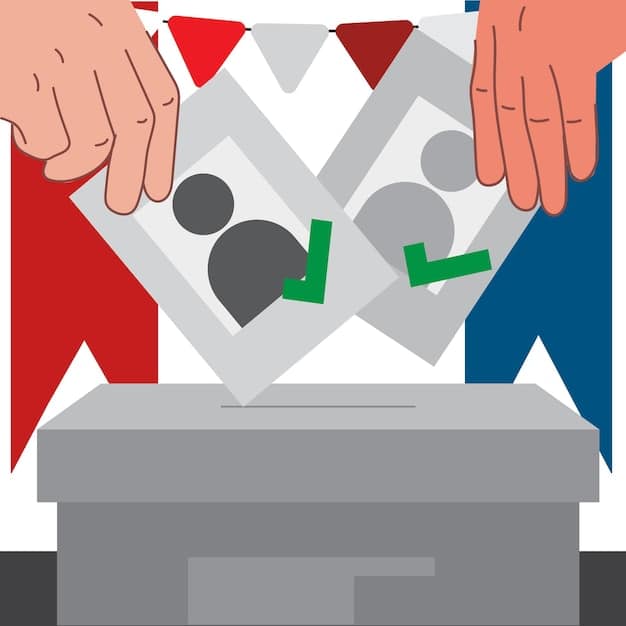Ranked-Choice Voting in the US: Benefits and Risks

Ranked-choice voting (RCV) aims to improve elections by allowing voters to rank candidates, potentially leading to more representative outcomes and reduced negative campaigning, but it also introduces complexities and concerns about voter comprehension and potential manipulation.
The debate around election reform is constantly evolving, and one proposal gaining traction is ranked-choice voting (RCV). But what are the actual potential benefits and risks of implementing ranked-choice voting in the US?
Understanding Ranked-Choice Voting
Ranked-choice voting, also known as instant runoff voting, presents an alternative to traditional plurality voting systems. It aims to address some perceived shortcomings of these systems.
Instead of choosing just one candidate, voters rank the candidates in order of preference: first choice, second choice, third choice, and so on. This allows voters to express a more nuanced opinion and potentially avoid “spoiler” candidates who might split the vote.
How RCV Works
The mechanics of RCV are relatively straightforward, though they can seem complex at first glance. Here’s a breakdown of the process:
- Initial Count: The first-preference votes are tallied for each candidate.
- Elimination: If no candidate receives a majority (more than 50%) of the first-preference votes, the candidate with the fewest first-preference votes is eliminated.
- Vote Redistribution: The votes of those who ranked the eliminated candidate as their first choice are then redistributed to their second choice.
- Repeat: This process of elimination and redistribution continues until a candidate receives a majority of the votes.
Essentially, RCV simulates a series of runoff elections, all within a single ballot. This ensures that the winning candidate has the support of a majority of voters, even if they weren’t everyone’s first choice.
This section walked through the basics of ranked choice to introduce how it serves as an alternative to simpler voting systems.
Potential Benefits of Ranked-Choice Voting
Proponents of ranked-choice voting argue that it offers several significant improvements over traditional voting systems. These benefits range from promoting more positive campaigning to ensuring broader representation.
One of the most frequently cited advantages is that RCV can lead to more moderate outcomes and reduce the influence of extreme candidates.

More Positive Campaigning
Because candidates need to appeal to voters beyond their core supporters to gain second- and third-choice preferences, RCV can incentivize more positive and collaborative campaigning. Candidates are more likely to focus on their own merits rather than attacking their opponents.
This can lead to a more civil and informative electoral environment, ultimately benefiting voters.
Broader Representation
RCV can also increase representation for minority groups and independent candidates. By allowing voters to rank candidates, it reduces the risk of “wasting” a vote on a candidate who is unlikely to win.
- Increased Viability for Third Parties: Voters are more likely to support third-party or independent candidates as their first choice, knowing that their vote will still count towards their second or third choice if their preferred candidate is eliminated.
- Reduced Incentive for Strategic Voting: RCV minimizes the need for strategic voting, where voters choose a less preferred candidate simply because they believe that candidate has a better chance of winning.
- Greater Choice: Voters can express their true preferences without fear of inadvertently helping a candidate they strongly oppose.
RCV offers some attractive benefits. A combination of positive campaigning and better representation can make for a friendlier electorate.
Potential Risks and Criticisms of Ranked-Choice Voting
Despite its potential benefits, ranked-choice voting is not without its critics. Concerns have been raised about its complexity, potential for voter confusion, and the possibility of unintended consequences.
One of the most common criticisms is that RCV can be confusing for voters, particularly those who are less familiar with the system.
Voter Confusion and Complexity
The act of ranking candidates can be more cognitively demanding than simply choosing one. Voters may struggle to understand the process, leading to errors or a sense of disenfranchisement.
Clear and accessible voter education is crucial for the successful implementation of RCV.
Potential for Manipulation
Some critics argue that RCV can be manipulated through strategic voting or by campaigns encouraging voters to rank candidates in a specific order.
For example, a candidate might try to persuade their supporters to rank a less popular candidate as their second choice, knowing that this could help them in the later rounds of vote redistribution.
Impact on Election Outcomes
It’s difficult to predict the precise impact of RCV on election outcomes. Some studies suggest that it can lead to more moderate results, while others find little or no difference compared to traditional voting systems.
Opponents can come up with potential pitfalls in this style of voting, including confusion, manipulation, and unpredictable outcomes.
Implementation Challenges
Even if the theoretical benefits of ranked-choice voting outweigh the risks, there are practical challenges associated with its implementation. These challenges range from the technical aspects of vote counting to the need for comprehensive voter education.
One of the most significant challenges is the cost of implementing RCV. It often requires new voting machines and software, as well as extensive training for election officials.

Logistical Issues
RCV can also create logistical headaches for election administrators. Counting the votes can be more time-consuming and complex, potentially leading to delays in election results.
Additionally, RCV may require changes to ballot design and voter instructions, which can add to the cost and complexity of elections.
Voter Education
Effective voter education is essential for the successful implementation of RCV. Voters need to understand how the system works, how to rank candidates, and how their votes will be counted.
- Public Awareness Campaigns: These campaigns can use a variety of channels, including television, radio, and social media, to educate voters about RCV.
- Demonstration Ballots: Providing voters with sample ballots that they can practice with can help them become more comfortable with the ranking process.
- Community Outreach: Election officials can partner with community organizations to reach voters who may be less familiar with RCV. Reaching specific voters can increase confidence.
Implementation challenges are no small concern especially if there is not sufficient support for voter understanding and logistical execution.
The Evolving Political Landscape
The adoption of ranked-choice voting is part of a broader trend towards election reform in the United States. As concerns about polarization, voter turnout, and representation continue to grow, policymakers and advocates are exploring a variety of ways to improve the electoral process.
Several states and cities have already adopted RCV, including Maine, Alaska, and New York City. These jurisdictions provide valuable case studies for understanding the potential benefits and challenges of RCV in different contexts.
Future Prospects
The future of RCV in the United States is uncertain, but it is likely to remain a topic of debate and experimentation for the foreseeable future. As more jurisdictions adopt RCV and more data becomes available, we will gain a better understanding of its impact on election outcomes and voter behavior.
RCV is just one piece of the puzzle when it comes to strengthening democracy and ensuring that elections are fair, accessible, and representative.
RCV is a system with an uncertain future, as it is constantly under debate and observation, for better or for worse.
Case Studies: RCV in Action
Examining real-world examples of ranked-choice voting can offer valuable insights into its practical effects. Several states and cities in the United States have already implemented RCV, providing a diverse range of case studies.
Maine was the first state to adopt RCV for statewide elections. Its experience offers lessons and pitfalls to consider.
Maine
Maine implemented RCV for primary and general elections in 2018. The implementation has faced political and legal challenges, but RCV has been used in several high-profile elections.
It is important to note that Maine’s experience with RCV is still relatively recent, and its long-term effects remain to be seen.
Alaska
Alaska adopted ranked-choice voting in 2020, along with other election reforms. The first election using the new system was held in 2022.
- Increased Voter Turnout: There was a modest increase in voter turnout compared to previous elections. This could be attributed to a variety of factors, but some observers believe that RCV may have encouraged more voters to participate.
- Shift in Campaign Strategy: Candidates focused on appealing to a broader range of voters and avoiding negative attacks, as they needed to secure second- and third-choice preferences.
- Complex Results: The vote-counting process was more complex and time-consuming than traditional elections, leading to some confusion and delays in reporting the final results.
From Maine to Alaska, RCV has shown itself in differing lights, where it has been successfully and unsuccessfully implemented.
| Key Aspect | Brief Description |
|---|---|
| 👍 Potential Benefits | More positive campaigns and broader representation. |
| 👎 Potential Risks | Voter confusion, potential manipulation, and complex implementation. |
| 🗳️ Real-World Examples | Maine and Alaska have implemented RCV with varying degrees of success. |
Frequently Asked Questions
▼
RCV is an electoral system where voters rank candidates in order of preference rather than choosing just one. If no candidate wins a majority, the candidate with the fewest votes is eliminated, and their votes are redistributed to the voters’ next choice.
▼
Some studies suggest RCV favors candidates who can appeal to a broad range of voters, potentially leading to more moderate outcomes. By nature, ranking forces you to show support to those who can appeal to you.
▼
The initial implementation of RCV may incur costs for new voting machines, software, and voter education. However, some argue that the benefits of RCV outweigh the costs in the long run.
▼
Voter education is crucial for the success of RCV. Local election officials, advocacy groups, and non-profit organizations often provide resources, including online guides, demonstration ballots, and community outreach events.
▼
Common criticisms include voter confusion, the potential for strategic manipulation, and the unpredictable nature of election outcomes. Critics also say the logistics of the system can make the polling process cumbersome.
Conclusion
The potential benefits and risks of implementing ranked-choice voting in the US are numerous and complex. While RCV promises more positive campaigning, broader representation, and potentially more moderate outcomes, it also raises concerns about voter confusion, manipulation, and implementation challenges. Ultimately, the decision of whether to adopt RCV will depend on a careful weighing of these factors and a commitment to ensuring that all voters have the information and resources they need to participate fully in the democratic process.





